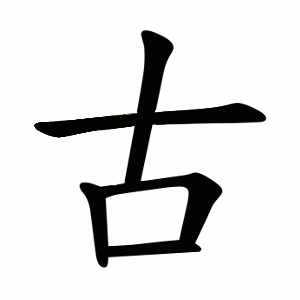古
- old;
- ancient;
Etymology
Composed of 十 (열 십, “ten”) + 口 (입 구, “mouth”), and is traditionally regarded as an ideogrammic compound.
The 口 is often interpreted as “speech” or “words,” while the 十 has two main interpretations:
• “Very large number” theory – 十 is taken to mean “a great number,” symbolizing stories and traditions passed down orally over countless generations, leading to the meaning “ancient times.”
• “Shield/armor” theory – 十 is seen as a variant of 干 (shield) or 甲 (armor), suggesting that stories about old battles gave rise to the meaning of “old” or “ancient.”
In oracle bone script (甲骨文 jiǎgǔwén), the form of 十 varied:
• sometimes drawn as a stick piercing through 口,
• other times drawn without piercing it.
This has led to different interpretations of its original image — some think it even looks like a church symbol on a map or a tombstone with a stele in front of it.
Words that derived from 古
Additional notes
故 a similar in meaning:
古 = “old, ancient” - comparable to past tense in English: describing something from long ago.
故 = “reason, tradition, something continuing from the past” - comparable to present perfect tense: something from the past that still has effect now.
Despite these nuances, 古 and 故 are sometimes interchangeably used in historical and literary contexts.
